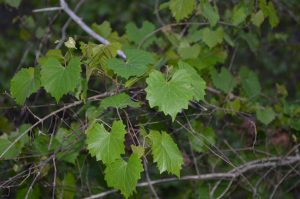
By Les Harrison
Wakulla County Extension Director
The climb to the top is always a challenge, but it is the goal of many. The route is never a straight line or simple.
There are constantly obstacles to identify, assess and then overcome. There are breaches and gulfs which test resolve with resolutions bordering on the incredulous.
Only the hardiest with an obsessive focus on reaching the pinnacle and the infinite patients to try every possible course will ever make it to the top. When the ultimate objective has been reached, it is time to spread out, conquer and defend the high point from other interlopers.
While this truism fits many situations involving people, it has been an ongoing competition in the Wakulla County’s natural environment since before recorded history began. Today, wild muscadine grapevines continue this age-old practice with their slow, but inevitable progress up and over anything within their reach.
The muscadine grape (Vitis rotundifolia) is native to the southeastern U.S. and was the first native grape species known to be cultivated in North America. Its native range extends from Delaware to central Florida and occurs in all states along the Gulf Coast to east Texas.
Muscadine grapes grow well throughout Florida, although performance is meagre in soils with very poor drainage, or calcareous content. These are soils which are very high in calcium, having developed from limestone deposits long ago.
This grape is in the same genus as the American bunch grapes, Vitis labrusca, which will not grow in this region of the country. Both V. Labrusca and its European cousin V. Vinifera quickly succumb to Pierce’s Disease, a bacteria common in this part of the country.
Wild muscadine grapes are functionally dioecious, in effect male and female. This is because of incomplete stamen formation in female vines and incomplete pistil formation in male vines.
Male vines account for the majority of the wild muscadine grape population, and bare no fruit. They are, however, required for cross pollination so the female vines produce.
In the wild, both male and female vines will climb up almost anything to in search of more sunlight. Trees are an especially susceptible to a heavy infestation of chocking coverage.
Small trees can be overcome with the weight and sun blocking capacity of wild muscadine vines. The parasitic relationship usually results in the death of the tree because of the weight of accumulated vines and excessive shading which stresses the tree’s growth capacity.
Central vines can exceed two inches in diameter, with each producing more vines at each node or joint along its way. A dense, interlaced tangle develops after a few years and any nodes touching the soil will put down roots.
Clipping the vines above their roots will kill the individual vine, but sprouting at the soil level occurs when the weather is warm. The individual cuts to secondary vines will result in vines “bleeding” sap when soil temperatures are high, but there is no evidence this is injurious to the overall vine.
To control in a landscape, wild muscadines must be aggressively pruned at the soil level or treated with herbicides. Repeated treatments and continues monitoring will be necessary.
Only the hardiest with an obsessive focus will success in controlling this native species.
To learn more about wild muscadines in Wakulla County, visit the UF/IFAS Wakulla County website at https://blogs.ifas.ufl.edu/wakullaco or call 850-926-3931.
 2
2
